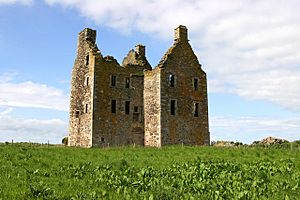Knockhall Castle facts for kids
Knockhall Castle is an old, historic castle in Scotland. It's located near a town called Newburgh in Aberdeenshire. This castle has a long and interesting story, going back hundreds of years.
Contents
The Castle's Story
Building Knockhall Castle
Knockhall Castle was built in 1565. A powerful person named Lord Sinclair of Newburgh had it constructed. Imagine how much work it took to build such a strong stone castle back then!
A Royal Visitor
A very important person, King James VI of Scotland, visited Knockhall Castle. He stayed there on July 9, 1589. This shows that the castle was an important and grand place at the time.
New Owners: The Udny Family
In 1634, a family known as the Clan Udny bought the castle. They moved in and made it their home. The castle became a central part of their family history.
A Time of Conflict
The castle faced some trouble in 1639. It was taken over by the Earl Marischal for the Covenanters. The Covenanters were a group of Scottish Presbyterians who supported their religion. Even after this, the castle was later returned to the Udny family.
The Great Fire
The Udny family lived in Knockhall Castle until 1734. Sadly, an accidental fire badly damaged the building. The fire gutted the castle, meaning it burned the inside completely. After the fire, the Udny family moved to their other property, Udny Castle.
Jamie Fleeman's Heroism
A special person named Jamie Fleeman is remembered for saving the family during the fire. Jamie Fleeman was known as the "Laird of Udny's fool." In those days, a "fool" was often a clever entertainer or companion. He is credited with helping the family escape the burning castle.
Knockhall Castle Today
Today, Knockhall Castle remains a ruin. It is a protected site, known as a scheduled monument. This means it's an important historical place that is kept safe.
What's Next for the Castle?
In late 2019, there were reports that the castle was for sale. If someone wanted to fix it up, they would need special permission. This permission is called "planning permission" and makes sure changes are done correctly.


